The World’s First U2 Spy Plane Photo Shoot at the Edge of Space
Eight years of discussions. Six months of training. Two days of final preparations. Much was required to give photographer Blair Bunting two hours at the edge of Earth’s atmosphere to conduct the first-ever photo shoot at near-space where he captured images that have never been made before and will likely never be made again.
It is impossible to overstate the difficulty of what Bunting has achieved. While photographing jets from other jets is incredibly difficult, it is something that many highly-trained photographers and filmmakers have done for decades. But the U2 Dragon Lady is a wholly different type of jet.

Designed by Lockheed Skunk Works in 1955, the U2 is a high-altitude reconnaissance aircraft that has been serving the United States Air Force for nearly 70 years, providing intelligence-gathering capabilities around the world from a height above 70,000 feet — more than double the altitude of commercial aircraft.

At that altitude, the environment can only be described as hostile. If a pilot were to eject from a traditional fighter jet, survival is expected. To eject from the U2 at altitude is most likely fatal.
The U2 flies so high that pilots must wear a full pressure suit — a space suit — in order to survive. It takes hundreds of hours of training in order to withstand even being in a U2 at altitude, let alone pilot it or perform any tasks within it.

Further, to say the cockpit is cramped is a vast understatement. While other USAF fighter jets don’t offer pilots or photographers much space to operate, the U2 cockpit is even more constricted. Add to that the sheer size of the space suit and even wielding a camera becomes nearly impossible.

The U2 is, in short, a spy plane. As such, just about everything related to these planes is veiled in secrecy. The pilots’ names and faces are hidden from the public and the exact altitude at which the planes fly is classified. As a result, there are few to no high-quality, produced photos of the U2 — none of which were taken at altitude and none of them close enough to see much detail.
Pilots occasionally capture photos of each other on their phones or compact cameras, but no commercial-quality photos have ever been taken.
Until now.
The Beginning
Blair Bunting made a name for himself in the commercial and advertising photography space thanks mainly to his excellent portrait work, but later in his career, he began to integrate vehicles into his portfolio. Tapping into his interest in military aircraft, Bunting has worked closely with the USAF for many years, including flying with the Thunderbirds and photographing the SR71.
As his relationship with the men and women at the USAF grew, Bunting formed a deep respect for their work and has repeatedly strived to capture their dedication the best way he knows how: through photos.

In 2015, he began conversations with the team at Beale Air Force Base to come up with a way to provide that to the U2 program. Because of the secrecy involved with their work, it is far more difficult to produce photos that are as striking as those made by other USAF squadrons.
In late 2022, Bunting received word that the USAF wanted to give him that chance and asked him to take his camera higher than any other airplane on Earth can go. When he was at altitude, only the International Space Station would be higher in the sky. That November, Bunting joined the team at Beale to start the process that would kick off six months of rigorous training. But first, he needed to get fitted for his space suit.


“I was sitting in my spacesuit as it was being fitted. The Air Force refers to this as ‘becoming integrated.’ Up until that point, I had been doing fine, with my nerves somewhat under control. Maybe it was the cocktails at night, maybe it was the idea that what we were undertaking was still months away, but somehow, I slept,” Bunting recalls.
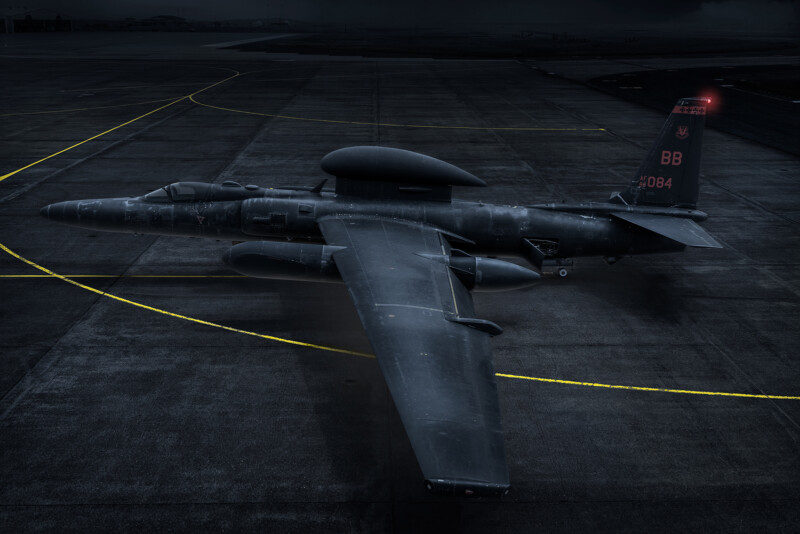
“Then came the moment they put my helmet on and locked the visor. Suddenly, I wasn’t able to write off what was about to happen as fantasy. At that moment, I realized I was going to go to the edge of space and do the very first photo shoot of another plane. What made this even more challenging for me was the recognition and acceptance that this piece, which hadn’t been done before, rested entirely on my shoulders.”
Unlike his past work which relied on teams of 20 or even 30 people to create, he would be alone. This was just him, sitting in a cockpit miles from Earth, surrounded by the blackness of space.

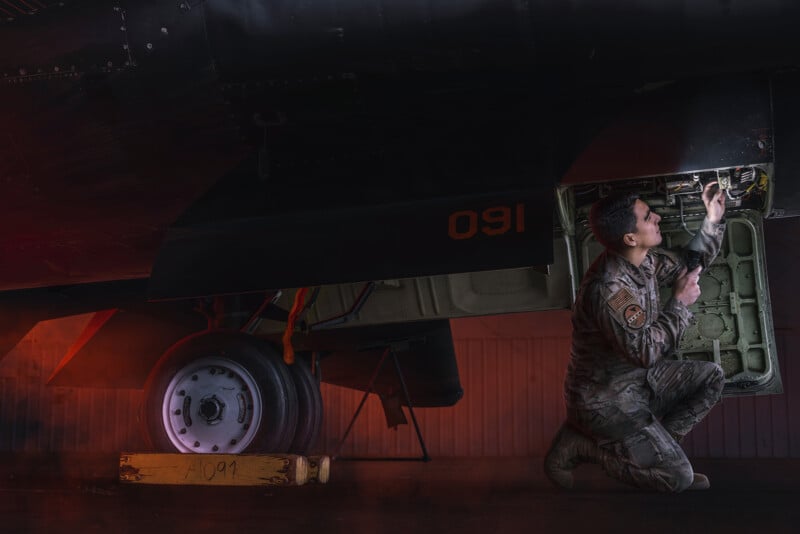
“While I want to say that the stress came from my desire and need to always get the shot, the truth is the pressure was self-imposed, born of the idea that I owed it to everyone around me,” he says.
“You see, you can’t just get into a spacesuit by yourself; you can’t even snap the helmet on alone, and I can’t fly a plane. All of these tasks required tons and tons of people. And over the years it took to prepare for this photo shoot until we would finally land after its success, I had grown fond of them. Not to mention, I would be entrusting my life to their hands come April. I wanted to give every bit of creativity and dedication I had and reward them with images. It was a profound opportunity that exists beyond what we fathom as rare.”
When Bunting left the base that day, he would begin the six months of grueling training required to complete his mission.
“Beyond the physical difficulties and the challenge of operating a camera while wearing a spacesuit, there were real mental battles that I would need to face in order to see this project through to its completion. Over the coming months, I quit drinking, started training three times a week, began meditating twice a day, and met with a psychologist to form a plan that would keep me focused throughout the flight,” Bunting explains.

“Perhaps the hardest of all, I turned down all photo shoots so that I could devote everything I had to this one. It wasn’t about the money, as there was none. This was a personal project from the beginning.”
Beyond just training his physical person, Bunting spent the next several months coordinating with military public affairs, ground camera crews, the pilots, and camera manufacturers to answer seemingly endless questions. Would the cameras operate correctly? Would they even fit in the cockpit? What aspects of the mission would be classified? With each answer, two more questions would sprout.
The months turned to weeks, turned to days. Before long, it was time.
T-Minus 48 Hours
Two days before the flight, Bunting and his crew and PetaPixel convened at Beale Air Force Base outside of Yuba City, California. Thanks to a particularly wet series of weeks in California, the hills and prairies were alive in bright greens, yellows, and purples.
Over the next two days, Bunting would be briefed on the details of the mission down to the minute, would undergo final testing of his space suit, and would sit for hours of final survival training in case the worst were to happen. Meanwhile, his crew and PetaPixel coordinated with Beale’s staff to organize the shooting schedule, cameras and their placement, and interviews.

As the hours passed, the weight of the mission began to weigh its heaviest on Bunting. As Staff Sgt. Alan Downs, 9th Operations Support Squadron and SERE Specialist (Survival, Evasion, Resistance, and Escape) explained the many things that could go wrong, how he might survive if they did, the reality of the situation bore down on the commercial photographer.
“The aspect of danger was never absent from any conversation about this project. In some ways, I’m grateful for the openness and honesty about the potential risks associated with flying at such altitudes. However, this also led me to discover the absolute limits to which your subconscious psyche can scare you,” he says.
Those who know Bunting best would recall how his eyes and demeanor changed over the course of the day. He was absolutely terrified.

“The pinnacle of this fear came two nights before my flight. For the first time, I woke up convulsing — not shivering, but flat-out shaking. The questions of whether or not I could execute the photo shoot and return safely teamed up in a tour de force of terror around 3 AM. I woke my wife and told her what was happening, and over the next hour, she helped to calm me down,” he recalls.
T-Minus 24 Hours
Bunting would spend the majority of the day leading up to the flight with space suit technicians whose job it was to assure his suit would resist the hazardous environment he was about to embark toward.
“We don’t send a lot of folks up there,” Lt. Col. Richard “T-Bone” Lang, 1st Reconnaissance Squadron Commander at Beale Air Force Base, says.

“It’s because of all the training. Going up that high, you have to be in a full pressure suit — or a space suit as we call it. If you’re up there without a space suit and you have an explosive decompression, and you’re above Armstrong’s line, your blood will start boiling so you only have about nine seconds until you’re dead,” he continues.

“That, combined with the parachute training, familiarization with the ejection seat, it’s kind of a big ask to get civilians up there.”

In a brief moment of rest between tasks, Bunting picked at his lunch, leaving most of it untouched. With his friends and family around him, he put on a face of bravery, and even laughed aloud. But inside, his emotions roiled.

“In the world of autism, they refer to this as masking — the idea that one can be experiencing different emotions internally than they are portraying externally,” Bunting later explained.

“This was never more true for me than when I had to mask the terror within me with a façade of focus and an exaggerated attention to detail in the days leading up to the flight.”
Liftoff
To his surprise, Bunting did not struggle to sleep the night before the flight. At about 4:30 the morning he would take off, he felt rested.
“It was then, and only then, that it truly began to sink in: I was about to go to the edge of space,” he says.

“I was excited, literally dancing in the shower before heading to the base. The months of buildup and endless ‘what ifs’ had cast a haze over the question of ‘will I get the shot?’ However, that morning, when I arrived at the base and saw my plane, something inside of me clicked, and I knew that I was going to create art that day.”

As Bunting suited up, his team prepared the U2. Operations at the base made it impossible to outfit the jet with the set of GoPro cameras that would record the shoot until just two hours before liftoff. Mike Maez, Bunting’s best friend, and outstanding photographer in his own right, hustled to equip the U2 with cameras that had been loaded with special firmware by GoPro to allow them to operate solely with external power, as the tiny cameras’ internal batteries would not last the entire time of the flight.

As noted, space in the cockpit is at a premium. The design of the U2 is made for its mission, not for show, so nearly every surface has a purpose. Visibility is also low, so adding cameras also risked reducing a pilot’s ability to effectively fly the plane. Because of this, the team was limited to just three cameras: one on each side of Bunting and one facing directly toward him.
Once the process started, there was no slowing it down. The U2 was fueled, the engine started, and the last GoPro was attached and confirmed only minutes before Bunting arrived at the hangar.

“With our spacesuits on, base personnel escorted us to the truck that would take us to our plane. All the while, my wife stood on one side of me, a military officer on the other, and a third person carried my liquid oxygen tank, through which I was breathing before being hooked up to the plane’s system,” Bunting recalls.
“The thickness of the helmet muffled sounds, but I can still recall approaching the aircraft as some auxiliary engines ran, making the massive metal structure seem almost alive. What probably took around 45 minutes felt like an entire day.

“My chosen gear was loaded into the cockpit along with me. After months of testing cameras and lenses, I decided to switch the primary lens I was going to use less than 24 hours before we were scheduled to lift off into the heavens. The last thing I remember before we left the hangar was watching the plane we would be chasing to the stratosphere roll by, the pilot waving at us. I waved back as if cheering on a teammate. The next thing I knew, I was sitting at the end of a runway, my pilot asking me to arm my ejection seat.”

The U2’s engine, which had to that point only gently hissed, roared and echoed across the flat landscape.
“We covered 100 feet, then 200, then 300. As we reached 400 feet, we started to lift off. For one brief moment, there was a smooth glide over the runway, but in an instant, that was over. The pilot pulled back on the stick as if we were trying to race away from the planet.”
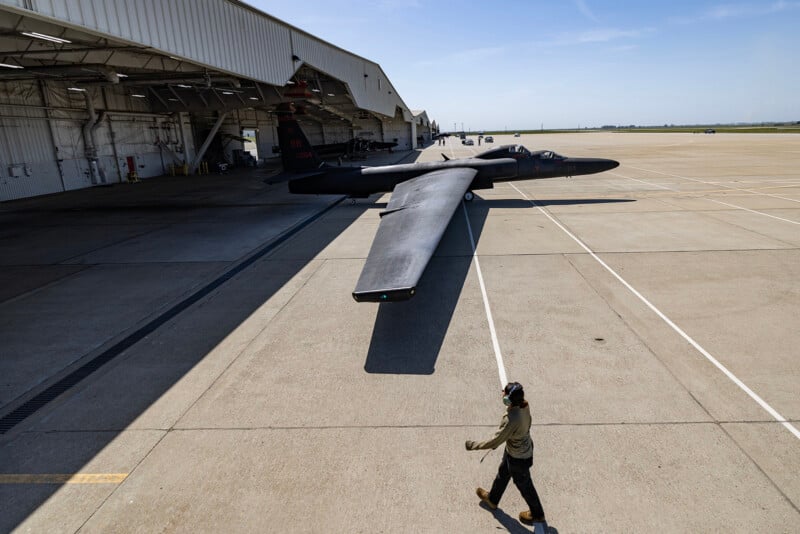
Unlike USAF fighter jets which take off almost like a rocket ship — nearly straight into the sky — the U2 is different. It is smooth, calm even, as it gently climbs to altitudes no other plane could dream of reaching.
“For the most part, it seemed like any other flight until my pilot radioed me and said we were above a commercial jetliner flying to LAX. It was nearly 35,000 feet off the ground, yet we were further above it than it was above the ground. It was the first time during the flight that my mind struggled to comprehend what it was seeing,” Bunting recalls.
“Not long after, we caught up with the other ship we were chasing, and together we ascended. Higher and higher we climbed, the saturated blue of the sky fading into blackness. For almost an hour, our two aircraft danced together above everything else. My pilot radioed back to inform me that I was conducting this photo shoot while being the highest human being on the planet, aside from those on the space station. It was a moment that profoundly struck me, not just because I was a photographer, but also because I was the eighth furthest person from the Earth — a situation I’m still struggling to comprehend.”
A Historic Photo Series
Bunting would spend the next few minutes coordinating with his pilot and the pilot of the other jet beside them. This would be the closest any pair of U2 planes had ever come to one another and gave Bunting the perspective he needed for his photos.


His pilot would fly around the other, giving him multiple vantage points. In one, the U2 can be seen set against the curvature of the Earth as colors dance across the vestiges of the atmosphere.

His jet would then move over and under for another angle, showcasing the bottom of the unusual plane and highlighted again by a rainbow of colors. Colors that are, importantly, not added for dramatic effect — these photos and all aspects of them, are real.
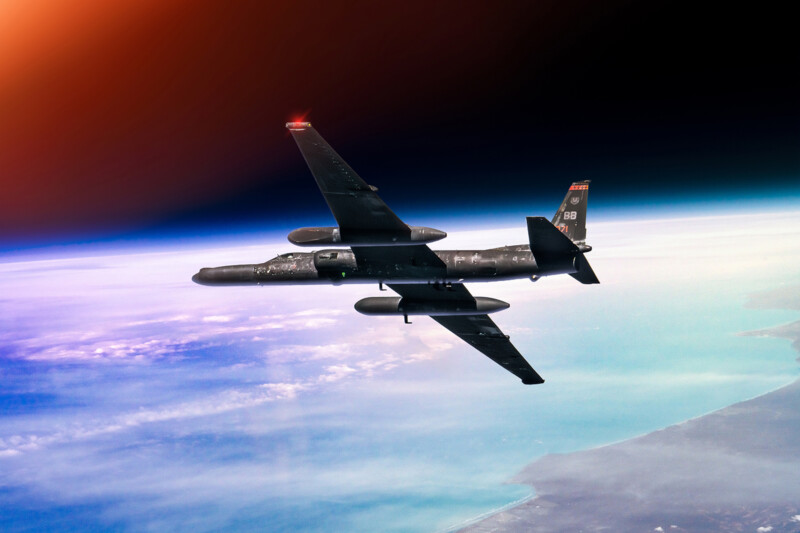
His final shot shows the U2 set against the blackness of space and surrounded by the ice that was forming on the canopy, ever encroaching and a constant reminder of the harsh environment.

“We began wrapping up the photo shoot with the other plane, as the cockpit around me was turning to ice. I snapped one last photo of the other aircraft surrounded by the frozen crystals on my canopy. It was a surreal sight; the sun illuminated the plane against a backdrop of space,” Blair explains.
The key images behind him, Blair’s pilot climbed ever higher.



“Everything was astounding: seeing the sun and the moon simultaneously against the black sky, looking up, then gazing down to witness the curvature of the Earth and its beauty, untouched by human activity. I continued to create images but took a few moments to appreciate the view before me. I had brought my dog’s tags with me, thinking sentimentally that I would feel closer to him as we soared towards the heavens,” Bunting says. His dog and loyal companion for more than a decade, Riley, had passed away earlier that year.
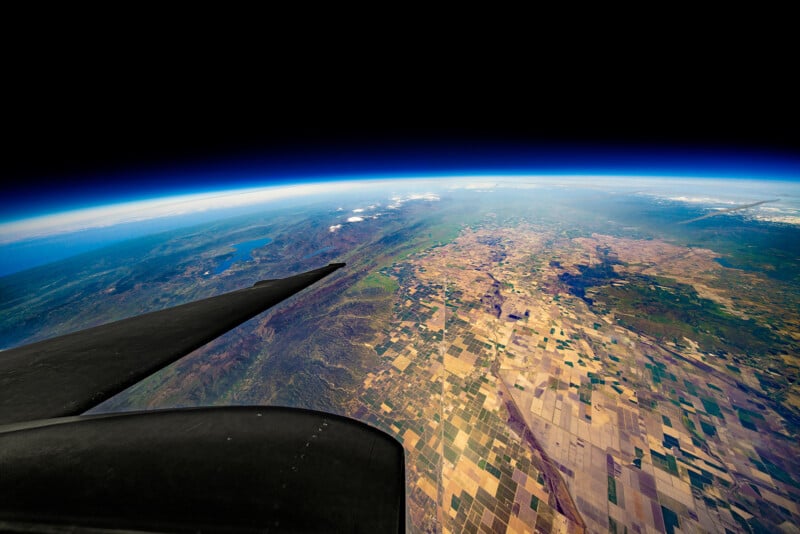

“After having lunch, squeezed out of a metal tube, and drinking like a hamster, the pilot and I decided it was time to return to the base. What is crazy about the U2 is that, at the altitude we were at, it might take just 45 minutes to ascend, but it can take hours to descend. The plane claws at any piece of the atmosphere it can, as if yearning to come home just as much as I was.


“There were periodic points in the descent when I realized I had just accomplished something no professional photographer had done before. I want to say that I celebrated, but I was too struck with disbelief to fully grasp the magnitude of the situation. More than anything, I was humbled to even have the opportunity to do a photo shoot that no man could ever have deserved, especially not me.”
Touchdown
As the wheels of his U2 touched down on Earth again, Blair released what can only be described as a primal scream, a private celebration of what he had done.
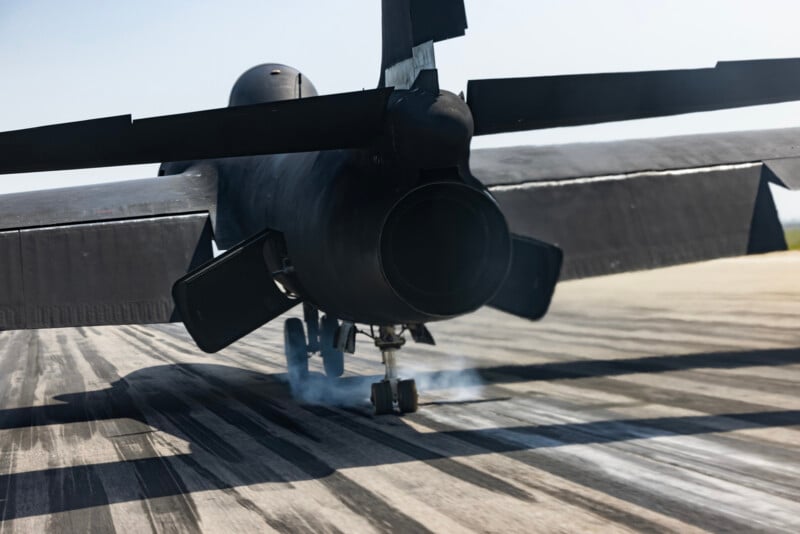
“There wasn’t just one car chasing us down the runway, but five. We taxied to a ramp where teams of military personnel, friends and family, more base personnel, and even a senator were waiting at the base of the steps, ready to celebrate,” he says.

Blair’s eyes saw them all, but searched only for one: his wife, Erin.
“I looked fervently through every window in the cockpit to find her face. She was the home I had yearned to return to. I wanted to give her a hug and a kiss. I wanted to tell her how much her support over the last eight months meant to me, but when I finally got to her, I didn’t have any words left”

As he embraced her amid cheers from the crowd, he quietly whispered into her ear the only words he could find.
“We did it, sweetheart.”
Blair Bunting is a Phoenix commercial photographer. The entire project “Photoshoot at the Edge of Space” and all associated photos can be seen PhotoshootattheEdgeofSpace.com. You can see more of his work on his website, blog, Facebook, and Instagram.
Special thanks to the United States Air Force and the exceptional members of Beale Air Force Base.